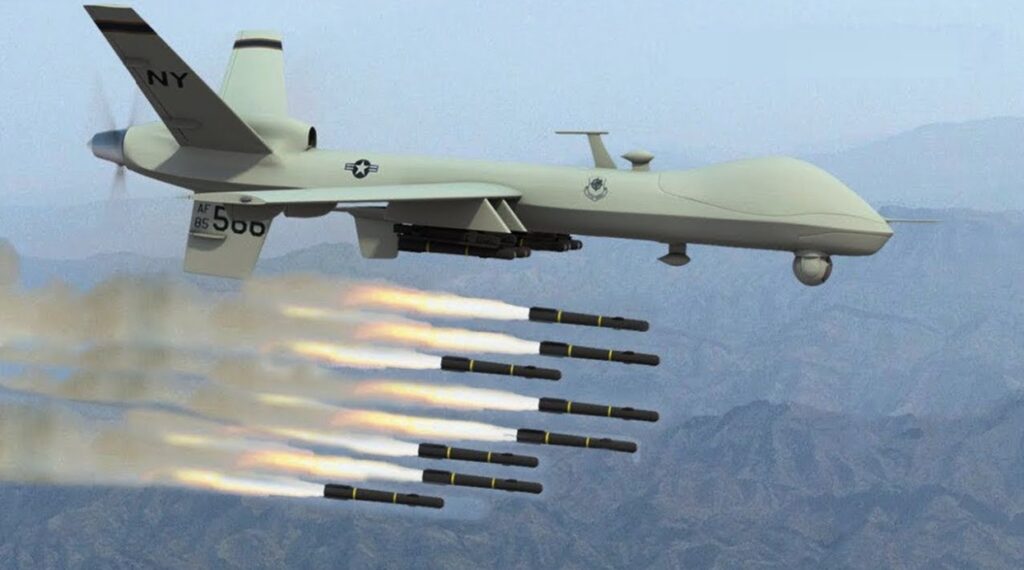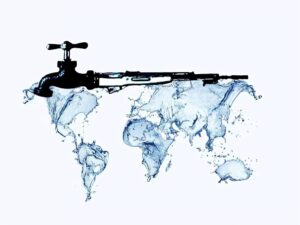Smart weapons systems... and their role in future wars?!

Written by: Dr. Tariq Al-Majzoub
Smart weapons are a type of weapon that hits their targets with pinpoint accuracy, is adept at evasion and maneuvering, tracks military targets in trenches and tunnels, and can adjust their plans according to battlefield conditions and the locations they target. These weapons include drones, cyber weapons, and satellites.
1. Drone as a means of war
A drone is an aircraft that can be pre-programmed or wirelessly piloted during flight, i.e., controlled or commanded remotely. In terms of guidance, there are two types: radio-piloted and autonomous, or self-piloted, drones that have relative autonomy in processing the information or data they collect and making appropriate decisions based on it. Drones can be divided into three basic types based on the missions they perform: first, surveillance drones; second, missile-launched drones; and third, dual-purpose drones, i.e., drones that can be used for both purposes simultaneously.
As drones have evolved from a reconnaissance, survey, and intelligence platform to a multi-mission aircraft in current and future military operations, such as dropped bombs or drone-launched smart missiles, drones can fly continuously for weeks and carry missiles weighing hundreds of kilograms, and drones are programmed to hunt down specific individuals. Engineers and aviation technicians have conducted research and development into these aircraft, including tactical aircraft, anti-ballistic missile aircraft, high-altitude aircraft, medium-altitude aircraft, casualty and supply transport aircraft, and miniature and miniature aircraft that will mimic flying birds and insects, after several technical issues, such as performance, are resolved.
2. Cyber as a means of war
An old, resurgent war is taking place between major powers (…) in which military and economic objectives overlap. The arena of this war is the internet, which has come to dominate the virtual world. Its soldiers are experts in computer science and the internet, adept at penetrating the security barriers of an adversary or competitor and hacking into it. This is what the New York Times revealed, citing cybercrime analyses that demonstrated, with a slight degree of suspicion, that the Chinese military's cyberwarrior unit is responsible for the majority of the attacks on American companies and even government ministries. The US President has warned that cyberattacks are a form of military aggression against his country, opening the way for a similar military response. The Chief of Staff of the Israeli Army also announced that the next war could begin with a missile targeting the General Staff or with a widespread cyberattack on civilian and military computers. Erez Kreiner, founder of the first cyber defense system in the Israeli General Security Service (Shin Bet), said: “In any future war waged by the Hebrew state, it will be subjected to multiple cyber attacks, and they will be able to hit the most sensitive and important Israeli sites.” He pointed out that, based on his experience, the enemy has achieved a great deal of technological advancement to undertake such actions, which would blatantly undermine Israeli national security. Kreiner noted that the enemy could launch an attack on Israel from Britain and France, pointing out that the classic Israeli security vision based on deterrence, deterrence, deterrence does not work in the field of cyber warfare, and anyone who does not believe in this becomes a suicidal person.
After reviewing the previous ideas and information, we perceive a significant international trend toward moving beyond the era of cybercrime, such as organized crime gangs and hackers, to cyberterrorism or state-sponsored cybercrimes eager to reap the greatest commercial or military benefits. Cyberwarfare is likely to expand and become increasingly entrenched. Laurent Gisel, Legal Advisor to the International Committee of the Red Cross (ICRC), believes that cyberwarfare refers to the use of methods and means of warfare, including electronic operations, that rise to the level of, or are used within, an armed conflict, according to the definition of international humanitarian law. Perhaps the most simplified definition of cyberwarfare is that it is a set of hostile actions directed against a state's electronic data, whether stored, processed, or exchanged from one computer to another, with the aim of discovering, copying, modifying, destroying, or obstructing its flow, such as attacks on military computers, missile systems, air traffic control systems, and nuclear reactors.
Some believe that future wars may begin with a cyberattack aimed at paralyzing the electronic systems of vital military and civilian sites or facilities, such as electricity, water, energy, communications, and transportation. These systems would then collapse, leading to greater woes than traditional armed conflicts. This war could be fought directly between two or more countries, or through a proxy—or third party—for example, a Russian cyber expert based in Germany attacks Ukraine via a server in Belarus. If the cyber investigation doesn't lead to Germany, or if the two countries don't have a judicial cooperation agreement, Ukraine has the right to attack Belarus, since the Russian remains anonymous in cyberspace.
In light of this cyber reality on Earth, Dr. Mohamed Zein, a professor of technology at Cairo University, said: “Many of the means of control and management of most vital processes on Earth have been transferred to space in the form of satellites and space stations. A wide range of wars and battles have also been transferred (…) to the virtual world that humans have created since the invention of computers, electronic memory, and information networks.”
3. Satellites as a means of war
The military uses of satellites and spacecraft orbiting Earth have diversified, monitoring global events, eavesdropping on telephone, radio, and internet communications, and conducting scientific experiments. The United States has exploited this scientific development and developed a project called Star Wars, also known as the Strategic Defense Initiative (SDI), launched by US President Ronald Reagan on March 23, 1983, with the participation of Israel, Germany, Britain, and France.
As several countries have begun to engage in this activity, which transcends their territorial borders and extends to the borders of other countries, it has become logical to say (…) “the possibility of war in space is not new.” Fearing Soviet nuclear weapons (…), the United States began testing anti-satellite weapons in the late 1950s, and even tested nuclear bombs in space before the prohibition of orbital weapons of mass destruction, following the 1967 UN Outer Space Treaty.
Military applications of space programs can be classified into defensive and offensive applications. Military satellites are used in warfare for the following applications: early warning, damage assessment from aerial or nuclear bombardment, electronic reconnaissance, eavesdropping on enemy military communications, securing long-range encrypted radio communications, evaluating offensive ground operations, photographing ground military targets, providing intelligence information, and monitoring compliance with arms control treaties and the use of satellite-guided munitions.
Thus, we are witnessing a significant international trend toward the weaponization or militarization of outer space, driven by countries' eagerness to reap the greatest military benefits. Outer space warfare is likely to expand and become increasingly entrenched.
Outer space warfare, space battle, or Star Wars is a space-based weapon warfare aimed at harming or destroying enemy infrastructure via cyberspace or outer space. This war also includes space espionage against the enemy, which is currently the most prevalent.
Perhaps the most simplified definition of outer space warfare is that it is a set of hostile actions directed against satellites and artificial devices, or their data stored, processed, or exchanged from a space-to-ground transmitting station to a ground-to-ground receiving station, with the aim of detecting, copying, modifying, destroying, or obstructing their flow, such as controlling North Korea's nuclear ballistic missile systems.
Military interest in smart weapons systems, or weapons systems enhanced so far with weak, limited, or narrow artificial intelligence, has led to the development of a wide variety of them. As mentioned earlier, these systems have been classified in terms of their autonomy or automatic guidance and their relationship to operators sitting behind computer screens into three types:
Semi-autonomous weapons or human-in-the-loop weapons that do not have freedom of action, because they are completely subject to and linked to the operators sitting behind computer screens, i.e., the control or domination of these systems.
Supervised autonomous weapons or Human on the loop weapons that do not have full freedom to act, i.e., to make appropriate decisions in light of the information or data they have collected, due to their being subject to and partially connected to operators sitting behind computer screens.
Autonomous weapons, or human-out-of-the-loop weapons, are weapons that do not process the information or data they collect and make appropriate decisions based on the commands and supervision of operators sitting behind computer screens. This is currently known as "fire and forget" for some drones, missiles, and rockets. By 2040, we may reach a stage beyond autonomous weapons systems, where systems that think and decide after they are fired, or weapons systems enhanced by strong, general, or comprehensive artificial intelligence.
Dual-use smart weapons systems, or self-guided smart weapons, are the talk of the town in Ukraine and the world today. They are the subject of controversy and disagreement among some military, political, intellectual, and legal circles. Discussions of them are often characterized by ambiguity, superficiality, or maneuvering. Perhaps some deliberately shroud them in mystery to conceal the true motives behind their advocacy.
Soon, this technological activity, once the exclusive domain of China, the United States, and Russia, became accessible to other countries or several international groups, as previously mentioned. As it became a distinct and ongoing sector of human and social activity, the need for a law to govern and regulate it became increasingly urgent. Given that several countries were now engaging in this activity, which transcended their territorial boundaries and extended to the borders of other countries, it became logical for this law to be international law.
Quoted from: Lebanese Army Magazine (adapted)
Link to the full text of the study:





